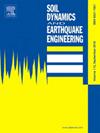Longitudinal shock absorption performance of energy dissipation prestressing joint between shield tunnel rings
IF 4.2
2区 工程技术
Q1 ENGINEERING, GEOLOGICAL
引用次数: 0
Abstract
To address the issue of damage and failure of circumferential joints in shield tunnels under strong earthquakes, this study proposes an energy dissipation prestressing joint (EDPJ) installed between shield tunnel rings. The basic structure and design method of the EDPJ are given. The mechanical properties of the main energy dissipation elements are tested by means of quasi-static experiments. A refined three-dimensional numerical model is developed to study the hysteresis behaviour of EDPJ. The damping performance of tunnels applying EDPJ is evaluated based on the generalised response displacement method. The results demonstrate that the damping force generated by the energy dissipating element of EDPJ is consistently stable, and the hysteresis curve shows a full rectangle. The EDPJ exhibits a well capacity for energy dissipation under cyclic loading, with a notable reduction in concrete damage, internal force, and opening width. The opening width between shield tunnel rings with EDPJ is significantly reduced for different earthquake magnitudes. The suitable arrangement of the EDPJs and the increase of the prestressing levels contribute to the improvement of the seismic damping effect of the joints. This study can provide reference for the design of longitudinal damping measures for shield tunnel engineering.
求助全文
约1分钟内获得全文
求助全文
来源期刊

Soil Dynamics and Earthquake Engineering
工程技术-地球科学综合
CiteScore
7.50
自引率
15.00%
发文量
446
审稿时长
8 months
期刊介绍:
The journal aims to encourage and enhance the role of mechanics and other disciplines as they relate to earthquake engineering by providing opportunities for the publication of the work of applied mathematicians, engineers and other applied scientists involved in solving problems closely related to the field of earthquake engineering and geotechnical earthquake engineering.
Emphasis is placed on new concepts and techniques, but case histories will also be published if they enhance the presentation and understanding of new technical concepts.
 求助内容:
求助内容: 应助结果提醒方式:
应助结果提醒方式:


